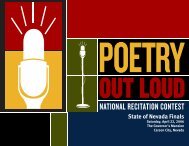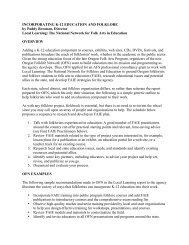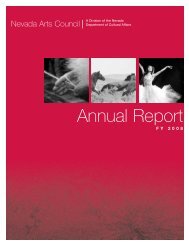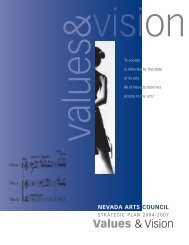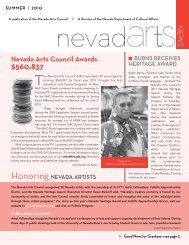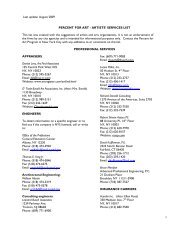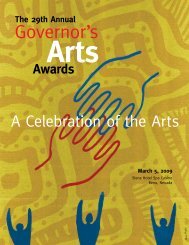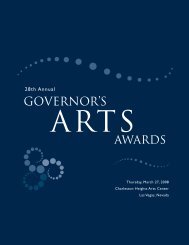Handed Down - Nevada Arts Council
Handed Down - Nevada Arts Council
Handed Down - Nevada Arts Council
You also want an ePaper? Increase the reach of your titles
YUMPU automatically turns print PDFs into web optimized ePapers that Google loves.
1993–1994<br />
Ukrainian Pysanky:<br />
Zoria Zetaruk, Luba Eads and Natalie Pruc<br />
The Wednesday morning Ukrainian egg class at<br />
the Dula Senior Center in Las Vegas is a cheerful<br />
place. The students hunch over their work, trading<br />
stories and jokes as they carefully draw lines on eggs with<br />
melted wax heated in small electric styluses. Instructor<br />
Zoria Zetaruk, an energetic 80-year-old woman, is<br />
everywhere, sketching the next step of the design on<br />
a blackboard, encouraging and praising, passing cups<br />
of red and purple dye around, noting the fine points<br />
of an intricate design, and joining in the good-natured<br />
kidding.<br />
Zoria has been teaching this class for 15<br />
years, ever since she arrived in Las Vegas, but<br />
her knowledge of Ukrainian pysanky is rooted<br />
in her earliest memories. Her parents were<br />
Ukrainian immigrants to Alberta, Canada,<br />
who insisted on teaching their children the culture<br />
of their homeland. She says, “My mother<br />
taught us early on how to make these Ukrainian<br />
eggs, and she had a double purpose why she<br />
did this—to keep the children quiet because<br />
she loved to write eggs, and if we weren’t writing<br />
eggs we’d be rambunctious. Therefore she<br />
sat us all around the table and all together we<br />
worked on these eggs. And then later on in life<br />
when my mother wanted us to do better work<br />
than we were doing, she knew another way of<br />
doing it. She would say, ‘Zoria, will you help me, I can’t<br />
see.’ She could see, but this was her way of getting me to<br />
help her, and getting into better designs and to knowing<br />
the tradition. And we would discuss the egg and<br />
what we were drawing and why we were drawing this,<br />
and that is how I got into the eggs.”<br />
Pysanky, which means “written”, are traditionally<br />
made for Easter and use Christian and pre-Christian<br />
symbols such as stars, crosses, flowers and animals to<br />
symbolize the rebirth of spring. Designs are drawn in<br />
wax on the egg, which is first dipped in a light dye such<br />
as yellow. More designs are drawn and the dyes become<br />
successively darker until the egg looks like a dark lump,<br />
misshapen with blobs of wax. When it is heated and the<br />
melted wax wiped off, however, the completed design<br />
appears as if by magic.<br />
Two of Zoria’s students, Luba Eads and Natalie<br />
Pruc, undertook an apprenticeship with her outside of<br />
the regular class. Luba was born in New York to Ukrainian<br />
immigrant parents, and has always had a strong<br />
interest in all aspects of the culture, but did not have a<br />
chance to learn pysanky until she met Zoria. Natalie was<br />
actually born in Ukraine, but left with her family when<br />
she was 12 and eventually came to Las Vegas. She was<br />
already a skilled practitioner of traditional Ukrainian<br />
embroidery, and had no trouble picking up the art of<br />
pysanky as well.<br />
Natalie Pruc, Zoria Zetaruk and Luba Eads.<br />
Luba Eads “writing” a pysanky design in wax.<br />
There is not much of a Ukrainian community in Las<br />
Vegas, but these three women, who all speak the language,<br />
prepare traditional foods, and carry on the art of<br />
pysanky, make sure their heritage is not forgotten even<br />
in the <strong>Nevada</strong> desert.<br />
30



